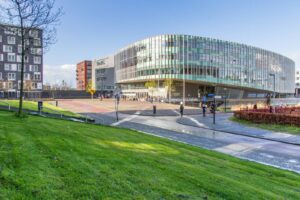For a few years now there has been a buzz about community thinking in the business world. Jeffrey Bussgang and Jono Bacon for example write about the competitive advantage that this kind of thinking can bring to a single company or organization: “If a company can transition from simply delivering a product to building a community, it can unlock extraordinary competitive advantages and both create and support a superior business model.”
At the same time, universities and ecosystem-builders have begun to notice how entrepreneurial communities create gravity that attracts and anchors talent and businesses to a specific place.
In this blog article Mikko Korpela, Head of Consulting at Crazy Town lists a few key insights for anyone interested in making use of community-driven approaches. This article is written with universities in mind, but the same universal rules can be used for any community-building.
1. Community-driven platforms can play a major role for universities interested in advancing research valorisation and engagement
“We need activity that inspires, enables and empowers researchers as well as students. Communities and community-driven platforms are a focal point for all things entrepreneurial. They need to build bottom-up to make grassroots change happen.” – Innovation officer at a Finnish university
Universities themselves are large academic communities with their cultures and rules. However, within such large communities, you can have smaller community-driven platforms focused on specific themes.
As demonstrated by studies (e.g. University-business-cooperation in Europe ), academics interested in greater engagement with businesses and society would benefit from having peer support, role models, and entrepreneurial culture around them.
Community-driven platforms can be a great tool for nudging the mindset in the desired direction – for example, research valorisation or commercialization. They showcase role models and also work as platforms to connect people with resources, services and talent.

Picture: Aalto Design Factory is a community of its own within the larger community of Aalto University. It has its own bottom-up culture and community rules.
2. TTOs / Innovation officers as community managers
Sometimes communities emerge by “accident” when like-minded individuals meet around a shared topic and find that they are passionate about it. They start doing things together, involve others in small tasks – and suddenly – a community emerges. However, often you also need someone to nurture the community as his/her proper job.
We call such people “community managers” and technology transfer offices of the future should have people like that in the team. They work as messengers strengthening the shared mission or interest of the community. TTOs / Innovation managers can take care of the community in constant interaction with the members. They orchestrate various information flows, communicate internally and externally, organize events and serendipitous encounters, build networks, coordinate and crowdsource.

Picture: Even though the profession of a community manager is still emerging and unrecognized, such people are often vital for the success of communities. There are examples of some of the skills they often have. Tip – Think about these when you are next hiring new staff members to your team.
To succeed in their mission, community managers need to have the right building blocks that they use routinely. Consistency is key!
3. Building blocks and tools
Be aware that people and organizations engaged in communities cannot be managed in traditional ways. Participation is voluntary and people expect reciprocity. Community managers can take a “leadership” role through facilitation by following routines.
Communities need an engagement and knowledge creation process
How to support engagement and knowledge creation in a community? One way to look at this is through SECI-model by Nonaka & Takeuchi (e.g. The Knowledge-Creating Company). It’s a theoretical framework that explains how tacit and explicit knowledge is converted into organizational and community knowledge. We’ve proven its real-life relevance for the past 20 years that we have been running communities.

Picture: SECI model (modified by Crazy Town).
The same as in any community we believe that it’s important to create circumstances that support knowledge flow and – creation inside the community. People in communities need time and space for informal and formal socialization. Basically “drinking coffee” and “throwing ideas around”. But to have this process mastered communities need also externalization, processes to document insight, combining and turning ideas into action. Co-creation, piloting and learning from it.
Community spaces
Video: Mikko and Toni explore Crazy Town Jyväskylä community space in an ad hoc video tour.
Communities and people often anchor themselves to a space that can either be physical, virtual or both. At its best, the community space enables the flow of information and knowledge creation within the community. For example, it’s easier to have random conversations within open, modern and ergonomic spaces than in small, overcrowdedcorridors or old school classrooms. Easy-to-access space works as a home base for the community.
A badly functional space may also block information and community building. We see this happening if the space is in the wrong location or doesn’t allow bottom-up engagement. Community members should be involved in the making of the space.
Communities can also exist partly or solely virtually. Virtual community spaces have the same requirements as physical ones. They can make the skills and needs of the community members explicit, facilitate matchmaking and allow content to be stored for easy access. Note that virtual spaces benefit from (virtual) community managers as much as the physical ones.

Picture: Crazy Town virtual community space
So, if you are interested in building a community?
Reflect about what we wrote. Here’s a couple of steps on how you can get started
- Find first followers, who want to get things started and share interest in what you are doing
- Start small and keep doing things, consistency matters
- Set shared mission-driven goals that motivate others
- Engage others in building things together
- Facilitate interaction and learning between people, organize activities
- Help members of the community to collaborate and share resources
- Connect the dots and help others to see new opportunities
- As the community grows and you keep doing good things, it becomes a virtuous cycle and you’ll attract more and more resources
We are looking for partners interested in building entrepreneurial communities, talent attraction and co creating ecosystems.
Mikko Korpela / Director | +358 400 499 242 | mikko.korpela@crazytown.fi https://www.crazytown.fi/en/



